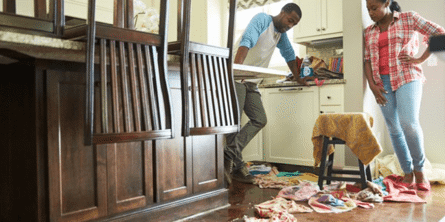If your home or business has experienced damage from flooding, you need to act fast to save as much as possible. When it comes to flood cleanup, there are some things you can and should do immediately, and other things you’ll need help doing. To ease your stress and guide you through what to do after a flood, the professionals at ServiceMaster Restore® put together a list of five critical flood cleanup tips.
1. CHECK FOR SAFETY HAZARDS
If you have flood insurance, call your insurance agency first to report your flooded home. Then, start to assess the damage. Here are a few questions you should ask to ensure your safety:
Is your home structurally secure? Call the experts for a safety inspection. Water damage can threaten the stability of your home, from its foundations and floors to its supporting beams and ceilings. If the flood water level is significant or you are concerned the structure might collapse, do not risk entering your home.
Is your power still on? Standing water mixed with electricity puts you at risk for an electrical shock – so don’t proceed without taking a few precautions. If you have safe exterior access to your breaker box, turn off the power before coming into contact with any standing water. If you don’t have access, contact your local power company before going inside. If you’re unsure whether your power is still on, do not enter your house, especially if the water level is above your outlets.
Is there a gas leak? If you smell any gas, do not enter your home. Gas leaks are extremely hazardous and potentially deadly. Alert your utility company right away if you suspect there is a gas leak in your home.
Is the flood water contaminated? Sewage and harmful chemicals often contaminate floodwaters, which can put your health at risk. If you suspect contaminated floodwater, seek help to assess the damage, start the cleanup, and protect your health and belongings.
Related: FLOOD AWARENESS AND PREPAREDNESS TIPS
2. REMOVE ITEMS WITHIN YOUR REACH
When it is safe to return to your home, remove as many items as you can to prevent further damage. Even items not in immediate contact with water can be damaged by increased humidity and moisture after a flood. The faster you remove items, the more likely they can be repaired or restored. Take particular care removing electronics – they too can create electric shock if powered up or plugged in, yet they are often the items you want to save most. Do not attempt to remove submerged electronics unless they are unplugged and your power is off. Dry any recovered items completely to prevent mold growth and water damage, then store in a secure, dry area. The sooner you call us, the sooner we can send a team out to help you recover as many items as possible.
3. EXTRACT WATER AND PREVENT MOLD
Depending on how high the water level is and whether you have carpets, you can attempt water extraction on your own or call in flood damage restoration specialists. If attempting to remove the water yourself, rent a wet vacuum or submersible pump and remove as much of the water as you possibly can. To prevent mold growth, it’s absolutely critical to keep the humidity level as low as possible while you dry your home and furnishings. Open as many windows as you can and run fans and dehumidifiers to increase the ventilation around your house and accelerate the drying process. We can exponentially accelerate the drying process by bringing in our specialized drying equipment.
4. CLEAN, SANITIZE AND RESTORE
Once water-damaged areas have dried out, including wood beams, carpets, and drywall, you must clean and sanitize the surfaces to avoid toxic mold growth, infection, and disease. All carpeting and upholstery need to be thoroughly cleaned and dried, as well, including carpet padding and cushions. Carefully wash and sanitize anything touched by floodwaters. You’ll need different techniques and approaches to clean floors, countertops, carpets and furniture, clothes, and personal belongings. Some items may be beyond saving and should be replaced. Once your home is dry, assess the level of damage to prioritize what gets cleaned and what gets replaced. We are able to thoroughly sanitize to prevent any mold growth, as well as remediate any mold that is already present.
5. KEEP A RUNNING INVENTORY
Keep a careful record of all damages, including pictures, videos, and any estimates and receipts for restoration or repairs. You’ll need these items for any insurance claims (this is something we are happy to help with as well!). Flood Cleanup and Expert Guidance ServiceMaster Restore® is by your side with our genuine commitment to getting you safely and effectively from crisis to resolution after a flood. If your home is flooded and you need guidance and expertise, call the professional water damage repair experts at ServiceMaster Restore® as soon as possible to handle the initial assessment, water extraction, and drying. We provide written estimates every step of the way and have technologically advanced tools to ensure proper flood cleanup. ServiceMaster Restore® also offers document restoration, electronics recovery, carpet cleaning, and mold remediation services to save your home and as many of your memories as possible after a flood. It’s never easy to clean up after a flood, but it’s easier with help from the experienced professionals at ServiceMaster Restore®.


